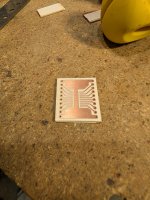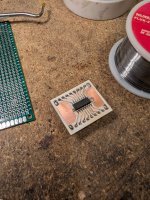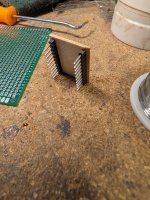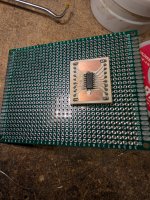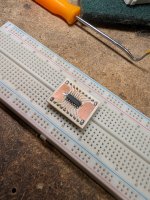Disclaimer - I am NOT an EE!
Backstory: after buying a handful of "TPA3116 D2" boards from AliExpress and having to modify a couple (for soft-on functionality)... I quickly discovered what many others likely have: that those boards are not real TPA3116 bords. Instead, they use CS8673E chips with "TPA3116" stamped into the top of the chip. It took some time of me poking around the interwebs, AliExpress and various chinese sites to track down what actual chip these knock-off boards were actually using.
As I have previously mentioned - these chips actually sound better to my own ears than the TPA3116. But this thread is NOT about the comparison of this chip -vs- others. The point of starting this thread is so I can compile all the info that seems to be missing about these chips into one spot for others to digest and have access to.
The chip itself requires very few external components (not even sure a buffer op-amp is needed!). They will operate on a very wide range of voltages, have all the same protection as the other TPA amps have, and will put out an honest 45 watts of real power when you give them the voltage they need.
The only info I really found for them was a single data sheet entirely in Chinese. First thing I did was translated the datasheet PDF into english the best I could.
But I wanted to tinker with these chips in some of my hand-assmebled proto board projects. So I went on a search for ESOP-16 adapters. While some variations exist, I could not find any that included the bottom pad (pin 17 / ground). This is not only important for ground, but also is used somewhat for heat dissipation. So I did my best and attempted to design an adapter in KiCad myself. I am sure it is far from perfect, but it is what I am going to use for my proto board testing.
All files are attached here to the thread.
The ESOP16_DIP_Adapter zip file includes the custom symbol for this chip as well as the footprint. I have printed off tests as well as just etched a board and it lines up perfectly with the chip. The point of this adapter is to basically turn this chip into a traditional through-hole component that will solder down into any normal proto board or breadboard. But feel free to use the symbol and/or footprint for whatever other custom project you may have.
It is surprising that - even though this chip is sold as a TPA3116 by the millions... there are not any real actual boards sold as what it really is (with optimized components, etc).
Also attached to this thread is an SVG of the adapter pcb directly. This is for those who want a no-bs way to JustMakeTheDamnCircuit(tm) without having to install or mess with KiCad, etc. The SVG prints a perfect dimensionally-acurate image on any decent laser printer which can then be used for transfer in order to etch. Likewise, the SVG also opens directly in lightburn and can be inverted to do the "paint the pcb, burn it, etch it, remove paint" method (as I do).
I will soon update this thread with my findings regarding circuit optimization, experimentation, etc. I will also stick a bunch of photos up in the coming days/weeks of what I build for those who are interested. I purchased a couple tubes of just the raw chips - so there will be a lot of trial and error!
This CS8673 chip really is a solid performer. As I have said elsewhere - it sounds very similar to my Rotel analog amps from late 90's and early 2000s. They are dirt cheap, perform well and require minimal external components to implement.
The resources I am posting here come with no warranty, no guarantee and are provided as-is in the hopes others may find this stuff useful.
- Dean
Backstory: after buying a handful of "TPA3116 D2" boards from AliExpress and having to modify a couple (for soft-on functionality)... I quickly discovered what many others likely have: that those boards are not real TPA3116 bords. Instead, they use CS8673E chips with "TPA3116" stamped into the top of the chip. It took some time of me poking around the interwebs, AliExpress and various chinese sites to track down what actual chip these knock-off boards were actually using.
As I have previously mentioned - these chips actually sound better to my own ears than the TPA3116. But this thread is NOT about the comparison of this chip -vs- others. The point of starting this thread is so I can compile all the info that seems to be missing about these chips into one spot for others to digest and have access to.
The chip itself requires very few external components (not even sure a buffer op-amp is needed!). They will operate on a very wide range of voltages, have all the same protection as the other TPA amps have, and will put out an honest 45 watts of real power when you give them the voltage they need.
The only info I really found for them was a single data sheet entirely in Chinese. First thing I did was translated the datasheet PDF into english the best I could.
But I wanted to tinker with these chips in some of my hand-assmebled proto board projects. So I went on a search for ESOP-16 adapters. While some variations exist, I could not find any that included the bottom pad (pin 17 / ground). This is not only important for ground, but also is used somewhat for heat dissipation. So I did my best and attempted to design an adapter in KiCad myself. I am sure it is far from perfect, but it is what I am going to use for my proto board testing.
All files are attached here to the thread.
The ESOP16_DIP_Adapter zip file includes the custom symbol for this chip as well as the footprint. I have printed off tests as well as just etched a board and it lines up perfectly with the chip. The point of this adapter is to basically turn this chip into a traditional through-hole component that will solder down into any normal proto board or breadboard. But feel free to use the symbol and/or footprint for whatever other custom project you may have.
It is surprising that - even though this chip is sold as a TPA3116 by the millions... there are not any real actual boards sold as what it really is (with optimized components, etc).
Also attached to this thread is an SVG of the adapter pcb directly. This is for those who want a no-bs way to JustMakeTheDamnCircuit(tm) without having to install or mess with KiCad, etc. The SVG prints a perfect dimensionally-acurate image on any decent laser printer which can then be used for transfer in order to etch. Likewise, the SVG also opens directly in lightburn and can be inverted to do the "paint the pcb, burn it, etch it, remove paint" method (as I do).
I will soon update this thread with my findings regarding circuit optimization, experimentation, etc. I will also stick a bunch of photos up in the coming days/weeks of what I build for those who are interested. I purchased a couple tubes of just the raw chips - so there will be a lot of trial and error!
This CS8673 chip really is a solid performer. As I have said elsewhere - it sounds very similar to my Rotel analog amps from late 90's and early 2000s. They are dirt cheap, perform well and require minimal external components to implement.
The resources I am posting here come with no warranty, no guarantee and are provided as-is in the hopes others may find this stuff useful.
- Dean
